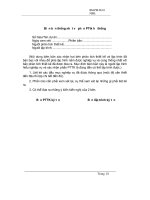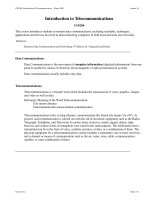ch 06 PPT lecture
Bạn đang xem bản rút gọn của tài liệu. Xem và tải ngay bản đầy đủ của tài liệu tại đây (1.91 MB, 36 trang )
Chapter 6 Lecture
Pearson Physics
Work and Energy
© 2014 Pearson Education, Inc.
Chapter Contents
•
•
•
•
Work
Work and Energy
Conservation of Energy
Power
Work
• While most people feel that work is done when
you "work on a problem" or "do homework,"
physicists say work has only been done when a
force is applied to an object and the object
moves in the direction of the applied force.
© 2014 Pearson Education, Inc.
Work
• Work being done as a force pushes a box
through a displacement. The work done equals
W = Fd.
• Units -- The product of F and d, N·m, is called
the Joule (J)
Work
• A joule is a small unit. You do a joule of work
when you lift a medium-sized apple through a
height of 1 meter.
• The table below provides some examples of
typical amounts of work.
Work
• It may come as a surprise that
no work is done while holding
a heavy object such as a
suitcase.
• By the definition of work,
because the suitcase doesn't
move, no work is done.
However, you become tired
because your muscle cells are
doing work holding the
suitcase.
Work
• Work is easily calculated when the force and
displacement are in the same direction, but how
is work calculated when the force is at an angle
to the displacement?
• The figure below shows a person pulling a
suitcase at an angle θ with respect to the
direction of motion.
Work
• In a case such as this, only the component of the
force in the direction of the displacement does
work.
• Notice in the previous figure that the component
of force in the direction of displacement is F cosθ.
Therefore, the work equals Fd cosθ.
© 2014 Pearson Education, Inc.
Work
• Work can be positive, negative, or
zero.
– Work is positive if the force has a
component in the direction of
motion (Figure a).
– Work is zero if the force has no
component in the direction of
motion (Figure b).
– Work is negative if the force has
a component opposite the
direction of motion (Figure c).
Work
• When more than one force acts on an object, the
total work is the sum of the work done by each
force separately.
• For example, if
does work W1, force
does
work W2, force
does work W3, and so on, the
total work equals
Wtotal = W1 + W2 + W3 + …
Work and Energy
• When work is done on an object, the object's
energy changes. For example:
– When you push a shopping cart, your work
goes into increasing the cart's kinetic energy.
– When you climb a mountain, your work goes
into increasing your potential energy.
• Thus kinetic energy is energy of motion;
potential energy is the energy of position or
condition.
Work and Energy
• Newton's laws and the equations of motion may
be used to derive a relationship between work
and energy.
• In the figure below, a box is pushed across an
ice-skating rink with a force F. Let's see how this
force changes the box's energy.
Work and Energy
© 2014 Pearson Education, Inc.
Work and Energy
• From the relationship
, we see
that the work done on the box (or on any other
object) is related to the quantity
.
• The quantity
is defined as the kinetic
energy, or KE, of an object of mass m and speed
v.
© 2014 Pearson Education, Inc.
Work and Energy
• In general, the kinetic energy of an object is the
energy due to its motion.
• Kinetic energy is measured with the joule, the
same unit used to measure work.
• The following table provides some examples of
typical kinetic energies.
Work and Energy
• The kinetic energy increases linearly with the
mass and with the square of the velocity, as the
following example indicates.
© 2014 Pearson Education, Inc.
Work and Energy
• As the equation
indicates, the
total work done on an object equals the change
in its kinetic energy. This connection is known as
the work-energy theorem:
© 2014 Pearson Education, Inc.
Work and Energy
• The following example shows how work is
related to the change in kinetic energy.
© 2014 Pearson Education, Inc.
Work and Energy
• The sign of the work is related to the change in
kinetic energy:
– If the total work is positive, then the kinetic
energy increases.
– If the total work is negative, then the kinetic
energy decreases.
– If the total work is zero, then there is no
change in kinetic energy.
Work and Energy
• The following example illustrates how the workenergy theorem may be applied when an object
has an initial speed.
© 2014 Pearson Education, Inc.
Work and Energy
• As the figure below indicates, work must be
done to lift a bowling ball from the floor onto a
shelf.
• Even though the ball has no kinetic energy once
it's resting on the shelf, the work done in lifting
the ball is not lost—it is stored as potential
energy.
Work and Energy
• Energy that is stored for later use is referred to
as potential energy, or PE.
• Potential energy has several forms, one of which
is gravitational potential energy.
• The gravitational potential energy equals the
work required to lift an object to a given height.
• Lifting a mass m from the ground to a height h
requires a force mg. Thus the work done, and
the potential energy acquired, equals force times
distance, or
W = mgh
Work and Energy
• The following example shows how the
gravitational energy is calculated.
© 2014 Pearson Education, Inc.
© 2014 Pearson Education, Inc.
Work and Energy
• Objects like rubber bands and springs that return
to their original size and shape after being
distorted are said to be elastic.
• Stretching a spring requires work. This work is
stored in the stretched spring in the form of
potential energy.
• The potential energy stored in a distorted elastic
material is referred to as elastic potential energy.
Work and Energy
• When a spring is stretched by a distance x, the
force exerted on the spring increases uniformly
from 0 to kx, where k is the spring constant.
• Thus, the average force is exerted on the spring
is
.
• Since the average force is
, the work done in
changing the length of the spring is the average
force times the distance, or
• This work is stored as elastic potential energy.









